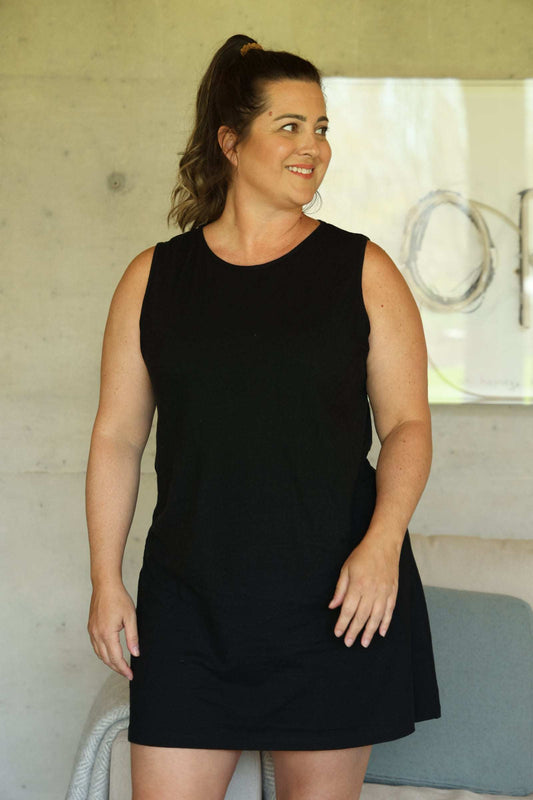
Menopause sleepwear pros and cons
Partager
This blog post is all about menopause sleepwear pros and cons.
If you've just bought some menopause sleepwear, be it pajamas or a nightgown, you might be expecting your first good, dry sleep in month, if not years. And that absolutely can be the case! Menopause sleepwear is specifically designed to help manage all the heat and moisture your body produces during the night. The fabric is designed to pull the heat and sweat away from you, ready for it to evaporate on the outer side of the garment, while storing some of the heat to release back to you during the chill phase of your night sweat.
But sometimes, your new sleepwear doesn't do what you want it to and you still wake up a soggy, hot/cold mess after a terrible night. What's happening? Why didn't it live up to your expectations?
Menopause Sleepwear Pros and Cons - a true story
Let me recount my experience with my own sleepwear to give you an idea of what's going on. Then we'll jump into why it happened - through no fault of the sleepwear.
A few years ago, we travelled from our home (Montreal at the time) to California. It had been a long travel day and by the time we arrived I was exhausted and eyeing my bed longingly.
I got into my Simone nightgown (great for travel, BTW) and snuggled under a duvet that was about 6 inches thick. Normally, a duvet that thick will make me break into a massive sweat just looking at it, but I was so tired that I was chilled and the warmth of the heavy duvet felt great.
I promptly fell asleep only to wake up in the middle of the night drenched in sweat. In fact, my Simone was completely soaked.
I got out of bed and walked around considering my options – I didn’t have another nightgown with me and I hate sleeping without anything on.
In the end I decided to keep my soaking wet nightgown on. I put a towel over the soaked bottom sheet and lay down on my side only needing the top sheet with my cotton bathrobe on top of it for warmth.
Within half an hour I was completely dry. I moved onto my back (my preferred sleep position), and promptly fell back to sleep.
Now, you’re probably thinking, “That doesn’t seem like a very good advertisement for your products. Your nightgown was completely soaked.”
So, let me explain what happened and why.
The bedding played a critical role, but so did my own exhaustion.
Here are the elements that had a hand in my waking up drenched.
- The thick down-filled duvet acted as a powerful thermal layer – thick and warm, trapping any heat I gave off under its cover.
- The luxury cotton sheets were super soft and comfortable – and also tightly woven which traps heat and moisture. Cotton loves water.
- I was completely exhausted leading to a drop in core body temperature – a signal telling you it's time for bed - to the point where I went into a very deep sleep, and slept right through several rounds of night sweats so I didn’t wake up to throw off my covers.
What’s happening while you’re sleeping
When you’re that tired, you won’t wake up even when your body is going through night sweats. And even though you’re that tired and started out so cold you needed a duvet, eventually your body decided it was time to turn on the old night sweats engine again and do its thing.
If your sheets and thermal layer (in this case a big thick duvet) are trapping all that heat, and sweat, there is nowhere for the moisture to go. It stays trapped under that duvet. And when you’re sleeping in luxury cotton sheets, the sheets will absorb a lot of that water. If the water can’t move to the next layer it will stay in those sheets and your sleepwear. As I've mentioned before, cotton loves water. Cotton is highly absorbent so it sucks that water up quickly. But it doesn't like to let go quickly. So, the thicker your cotton sheets, the longer they take to dry.
To make matters worse, once your body gets into its night sweats cycle, your night sweats will be more frequent if your environment is too warm – and that lovely duvet is keeping all the heat there, promoting even more night sweats cycles.
The more cycles you have before you wake up, the more soaked you’ll be when you finally do wake up.
This is exactly what happened to me.
Because I was in deep sleep and didn’t wake up to throw off my covers during a night sweat, the moisture had nowhere to go so it just stayed in the sheets and sleepwear.
When I woke up soaked, I was surprised – not because I was wet, but because I was so exhausted that I’d slept through enough night sweats cycles to make me soaked.
So, as I like to say, even the best moisture-wicking, heat- managing, sleepwear in the world won’t keep you dry in a sauna.
What can you do?
This is where the pros and cons of menopause sleepwear come into play.
Pros: when menopause sleepwear is used in conjunction with bedlinens that are breathable and heat managing, menopause sleepwear is your first line of defense against your night sweats. It will quickly draw that heat and moisture away from your body and transfer it to the next layer. That layer (sheets) will transfer it to the next layer (your blankets) where it can escape. All these layers work together to keep you dry and comfortable.
Cons: Menopause sleepwear will have more difficulty in keeping you dry and comfortable when you're sleeping in fabrics that trap heat and sweat next to you. Those layers prevent the heat and moisture from escaping so the heat and moisture will stay trapped in your sheets or sleepwear. Even if you don't use sleepwear, your sheets behave like sleepwear and they will be soggy and damp if the thermal layer is preventing the heat from escaping.
Your ultimate goal is to sleep in layers just warm enough to keep you comfortable, but not so powerful that they trap all the heat next to you. Those layers should draw the moisture from one layer to another to the outside of your last thermal layer where it can easily evaporate.
If you're wondering what the best fabrics for sleeping in are to keep you comfortable when you suffer from night sweats read
5 tips for better sleep with fabric
Thanks for reading!




